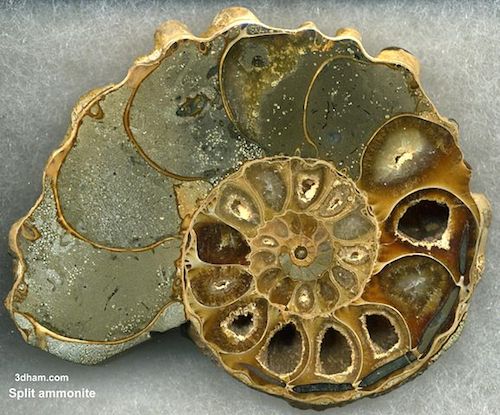 Evolution
Evolution
 Intelligent Design
Intelligent Design
Are Shell Spirals "Merely" Works of Physics?

A statement from CNRS, the French National Centre for Scientific Research, touts research in the Journal of Theoretical Biology. The news release states flatly, "Physics determined ammonite shell shape." It goes on to say that, even though individual shells of different species are "exceptionally diverse," they can all be explained by a biomechanical model.
"Their approach provides new paths for interpreting the evolution of ammonites and nautili," the article boasts. What’s missing in this story? Well, it is hidden away behind the word "emergence."
The shape of living organisms evolves over time. The questions raised by this transformation have led to the emergence of theories of evolution. To understand how biological shapes change over a geological time scale, researchers have recently begun to investigate how they are generated during an individual’s development and growth: this is known as morphogenesis. Due to the exceptional diversity of their shell shapes and patterns (particularly the ribs), ammonites have been widely studied from the point of view of evolution but the mechanisms underlying the coiled spirals were unknown until now. Researchers therefore attempted to elucidate the evolution of these shapes without knowing how they had emerged. (Emphasis added.)
Ammonite shells are famous for conforming to the Golden Ratio of the Fibonacci sequence (see this mesmerizing artistic video). Strangely, the news release did not mention that. All the researchers called on to do the artwork were forces and rates:
By examining various fossil specimens in light of the simulations produced by the model, the researchers observed that the latter can predict the number and shape of ribs in several ammonites. The model shows that the ornamentation of the shell evolves as a function of variables such as tissue elasticity and shell expansion rate (the rate at which the diameter of the opening increases with each spiral coil).
With their model, they believe they’ve got the shape solved as well as its evolution:
By providing a biophysical explanation for how these ornamentations form, this theoretical approach explains the diversity existing within and between species. It thus opens new perspectives for the study of the morphological evolution of ammonites, which seems to be largely governed by mechanical and geometric constraints….
More generally, this work highlights the value of studying the physical bases of biological development: understanding the "construction rules" underlying the morphological diversity of organisms makes it possible to partially predict how their shape evolves.
Here’s what’s missing: information. If cells were not pre-programmed with the ability to secrete proteins and minerals in the right orientations, at the right times, a spiral shell obeying the Fibonacci sequence would not result. If only forces and expansion rates were operating blindly, there would be a chaotic jumble.
What controls the tissue elasticity? The information in DNA. What governs the shell expansion rate? The information in DNA. What determines the geometric constraints? The information in DNA. The ammonite takes advantage of physics, but the shell is not merely a product of physics; it is directed by programmed information.
But critics of intelligent design could argue, don’t we find the same spirals in galaxies and hurricanes? Don’t they, too, conform to the Fibonacci sequence? Yes, but those phenomena are not directed by DNA to make the spirals for a function. The ammonite shell has a function: to provide a habitat for the squid-like animal inside.
We might compare a natural snowflake to a piece of jewelry imitating a snowflake. The latter has a function — to be an adornment. No natural law acting on silver ore in the ground is going to produce a snowflake shape by chance in a reasonable amount of time.
Similarly, inanimate forces devoid of information do not pull material out of seawater and organize them into chambered spirals that function as houses for cephalopods. You’ll notice that the CNRS researchers call their model a "biophysical" model, not just a physical model. Hidden in the "bio" part is the genetic information that directs the "physical" part.
If the researchers feel that physics alone can produce ammonite spirals, we might ask if physics alone can also produce the video about Fibonacci ratios in nature that we referenced earlier.
The Design Filter can distinguish between phenomena that appear outwardly similar, like the spiral galaxy and the ammonite shell. The former can be explained by natural law and chance. The latter cannot, because the forces available in seawater are inadequate and too improbable. We can therefore not only infer design, but actually observe the information in the DNA acting to produce the result.
Why would the universe be organized in such a way that the Fibonacci sequence shows up in so many places, including in non-living objects like spiral galaxies and hurricanes? If natural laws are contingent, the number of possible universes allowing such outcomes must be vanishingly small. This suggests even deeper levels of design in the fabric of the universe. As William Dembski argues in his new book Being as Communion, it’s "information all the way down."
